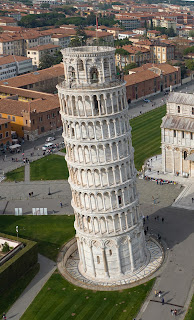The Leaning Tower of Foresight
A couple weeks ago, my wife and I found ourselves in Coralville ahead of a wedding we’d been invited to attend. With time to spare over the lunch hour, we went to Olive Garden. There, I saw a picture of the Leaning Tower of Pisa.
Curiosity piqued, I did what most modern youngish couples do on dates and took out my phone.
While I waited for my unlimited soup and salad, Wikipedia told me the tower was built over a span of 199 years, beginning with foundation work in the year 1173. By 1178, the foundation began to settle, causing the lean that would both plague and protect the tower for the next 850 years.
Construction ceased while the republic of Pisa battled with other republics in the region. Those battles kept Pisa busy for most of a century, which was good because it gave the tower time to settle. Had construction continued, it would almost certainly have fallen over.
Construction began again in 1230, then stopped in 1284. Another battle. Work began again in the early 1300s and finally concluded with the bell tower in 1372, a mere 199 years after the first stones were placed on poor subsoil.
Interestingly, the soft soil that caused the tower to lean also buffered it from at least four strong earthquakes since.
There’s obviously a lot more to the story, like how the tower is curved due to later builders constructing walls on one side taller than the other to compensate for the lean. But that’s not why this tower has been stuck in my brain since reading about it to my wife at Olive Garden.
What gets me is the timeline. This tower took two centuries to build! And I get frustrated about a multi-year four-lane highway project taking “forever.”
When you think about it, in nation or society terms, we here in the US are toddlers compared to most of the rest of the world. And unfortunately, I think some of our politicians seem to take that role a bit too seriously.
Heck, half of the states in our Union have existed as states for less time than it took to build the Tower of Pisa.
Which makes me question the timeframes we use to think about the future and to subsequently make decisions. In community planning, it’s not uncommon to talk about ten and even twenty-year plans. But never have I been privy to anyone discussing century-scale timelines. Most political terms are four to six years. Charles Grassley notwithstanding, few politicians enjoy the kind of tenure that builds towers. Wall Street thinks in terms of quarterly profits, and I’ve heard the average American’s attention span is eight seconds or less.
For most humans, myself included, it’s hard to consider a future beyond that which our grandkids might see.
What would our cities look like if we used a 200-year planning horizon? What would our priorities be if we could set and stay focused on centuries-long goals? If we cared enough about generations of people we’ll never know, would our decisions change? Would we, for instance, take measurable actions to mitigate the climate changes we’re already beginning to see? Would we plant more trees?
A lot of scientists seem to talk in 50-year horizons. Is that because we’re incapable of worrying about things beyond then? Just thinking about what the world will be like 200 years from now breaks my brain a little. I don’t know for sure what next week will bring, let alone next century.
But I think it’s worth giving some thought to. Because here’s the reality: Relatives and descendants we’ll never know will be either the beneficiaries or victims of the world we leave them.
The places we create or destroy, the resources we conserve or squander, and the knowledge and values we impart upon the next generation will all have cascading effects long after we’re gone. This is the benefit I get from working in conservation. If I plant an oak tree, I know I’ll never see it at full maturity. It could conceivably outlive my kids, their kids, and another generation beyond that, assuming Iowa’s climate stays suitable for oak trees over the next two centuries.
I often talk about “playing the long game” in terms of the lands we secure, the parks we establish, and the people we teach. Yes, we have five- and ten-year plans, but most of those objectives are in service of generations to come. But even then, I seldom think beyond the descendants I’m likely to know in my lifetime. Do my decisions change when I think about our county park system a century or two from now? It’s an interesting thought experiment for sure.
What about you? If time travel was possible (maybe it is in 200 years) and you could jump forward to meet your N-th degree grandchild, will he be happy with the decisions you’re making? Will she be blessed or cursed with the world we left?
I don’t know the answers and I’m not advocating for any specific action other than for you to think past a future that’s easy to see. Look into the murky depths of what might be and know that somewhere far down that timeline, someone will eventually look back and wonder why we made the choices we did. I’d like to be able to give a justifiable answer.
Could you?
Tower photo credit: Arne Müseler / www.arne-mueseler.com, CC BY-SA 3.0 DE <https://creativecommons.org/licenses/by-sa/3.0/de/deed.en>, via Wikimedia Commons


Comments
Post a Comment